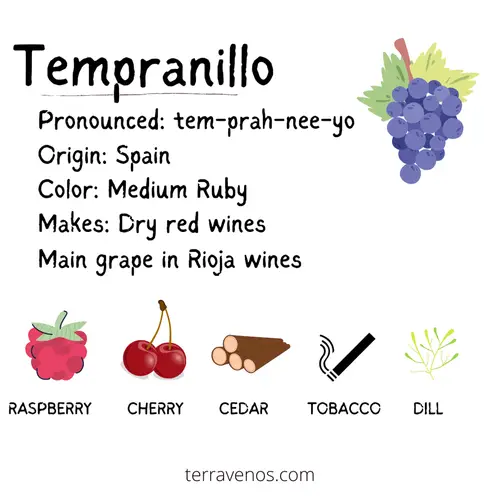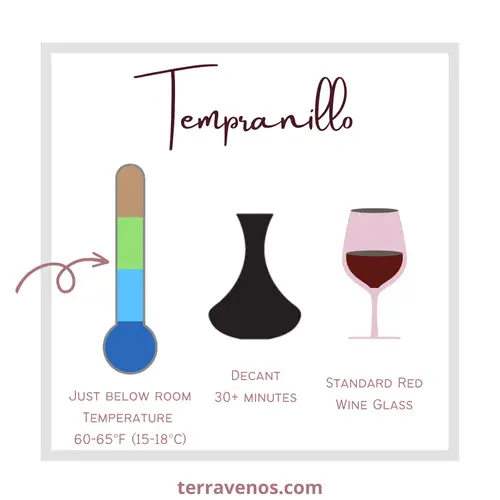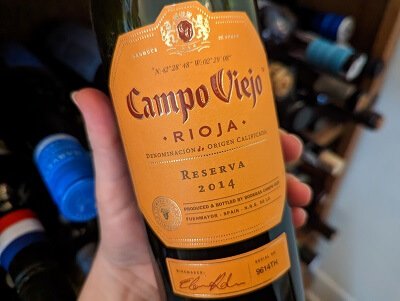| Characteristics | Tempranillo | Rioja |
|---|---|---|
| Hue | Deep purple to ruby | Deep ruby to garnet |
| Color | Red | Red |
| Blending | Possible | Traditional |
| Aromas | Red berries, plum, tobacco | Red berries, vanilla, coconut, dill, tobacco |
| Sweetness | Dry | Dry |
| Acid | Moderate to high | Moderate |
| Tannin | Moderate to high | Moderate to high |
| Alcohol (%) | 13-14.5% | 13-14.5% |
| Body | Medium to full | Medium to full |
| Intensity | Moderate to pronounced | Moderate to pronounced |
| Key Growing Regions | Spain, Portugal, California | Rioja (Spain) |
| Classic Pairings | Grilled meats, lamb, hard cheeses | Grilled meats, Spanish dishes |
| Rioja Levels | N/A | Joven (youngest), Crianza, Reserva, Gran Reserva (oldest) |
| Price Range | $10-$40 | $15-$100+ |
If you’re comparing Tempranillo vs Rioja, you’re asking smart wine questions. Pour yourself a glass of liquid encouragement.
Tempranillo is a type of grape, and Rioja is the place in Spain where they make wine using mostly Tempranillo grapes, but also other grapes, too, like Garnacha.
Comparing Tempranillo vs Rioja is a perfect way to learn about these two common red wines. Here’s a quick video to compare the two summarizing the differences:

- Tempranillo Basics: Spain’s Red Wine
- Rioja: The Region and the Wine
- Are Tempranillo and Rioja Similar?
- What Is the Difference Between Tempranillo and Rioja?
- What to Pair with Tempranillo and Rioja Wine
- How to Serve: Tempranillo and Rioja
- Which Is More Expensive, Rioja vs Tempranillo?
- Final Thoughts – Tempranillo vs Rioja
- Thirsty for More?
Tempranillo Basics: Spain’s Red Wine

Tempranillo, a well-regarded grape originating from Spain, has gained worldwide recognition for its robust character. Now a global favorite, Tempranillo thrives in vineyards worldwide, from Spain’s Rioja and Ribera del Duero to New World regions.
With its deep crimson color, Tempranillo offers a palate of red berries complemented by subtle hints of coconut, herb, and cedar. This flavorful profile has made it popular among wine enthusiasts globally and, hopefully with you, too.
Fun Wine Fact: Tempranillo gets its name from the Spanish word “temprano,” meaning early, as it usually ripens before many other grape varieties.
Helpful Tip: Here’s a complete guide to Tempranillo.
Rioja: The Region and the Wine
Rioja is the name of a geographical region in Spain that produces Rioja wines. You can scroll out using the map above to see where we are in the world. Rioja sits in the Ebro River valley with layered sedimentary soils and varied elevations, from high altitude cool vineyard sites, to lower altitude warmer vineyard sites.
Unique climatic regions mean that different kinds of grapes, or grape varieties, will do better in certain areas. Because of this, Rioja has a rich history of blending different grape varieties together to make wine.
Grapes Used to Make Rioja Wines
Rioja Wine Grapes and Their Contributions
| Grape Variety | Contribution to Wine |
|---|---|
| Tempranillo | Provides structure, red fruit flavors, and aging potential |
| Garnacha (Grenache) | Adds body, alcohol, and red fruit characteristics |
| Graciano | Contributes acidity, aromatic complexity, and aging potential |
| Mazuelo (Carignan) | Enhances color, tannins, and adds earthy notes |
| Maturana Tinta | Provides unique flavors and contributes to wine complexity |
Rioja Wine Law
Rioja wines follow strict aging requirements set by the Rioja Consejo, with several different categories. These categories are Joven, Crianza, Reserva, and Gran Reserva.
Helpful Wine Tip: Rioja wineries are aging their Rioja wines for you. If you buy a Crianza, for example, you can enjoy it now. No need to hold onto your bottle and cellar it longer.
Rioja Wine Aging Categories
| Category | Time in Oak Barrels | Time in Bottle |
|---|---|---|
| Joven | None or minimal oak aging | Released shortly after production |
| Crianza | At least 1 year in oak barrels | Minimum total aging of 2 years |
| Reserva | At least 1 year in oak barrels | Minimum total aging of 3 years |
| Gran Reserva | At least 2 years in oak barrels | Minimum total aging of 5 years |
Joven Rioja Wines
Joven Rioja wines are the youngest and freshest category of Rioja wines. They have no aging requirements and will be the least expensive.
Crianza Rioja Wines
Crizanz Rioja wines are aged for a minimum of one year in barrel, two years total. They’re still young a fruity, but a more integrated and balanced than Joven wines. The grapes that go into these wines aren’t the best, but they may be the winery’s best value for flavor and price.
Reserva Rioja Wines
Reserva Rioja Reserva aren’t made every year and require at least 3 years of aging, one in barrel. The winery often holds these wines back longer, though. They’re full of tart cherry, tang, leather, dill, and earthy. The tannins are softer and the wine is starting to develop a noticeable garnet or brick hue.
Gran Reserva Rioja Wine
Gran reserva Riojas wines are only made in the best vintage with the best grapes. They require 5 years of aging, with 2 in oak, so the grapes that go into the wines must have the quality to withstand all of that time maturing in the winery.
Fun Wine Fact: The Spanish have a long history of aging wines in American, not French, oak, thanks to their ties with the Americas as trading partners. American oak imparts coconut and dill. Check out this post on oak and wine.
Are Tempranillo and Rioja Similar?
Because Rioja wines have a larger percentage of Tempranillo, both share a red fruit, tobacco, and dill profile in your wine. Expect similar body, acid, and tannin levels, though this can vary depending on the wine producer and region where the grapes came from.
What Is the Difference Between Tempranillo and Rioja?
If you’re holding a bottle of Tempranillo, it’s unlikely that it was made in Rioja, Spain. Rioja can only come from the Rioja region in Spain. Other fun names used for Tempranillo include:
- Tinto Fino
- Tinta del País
- Tinta de Toro
- Ull de Llebre
- Cencibel
- Tinto Roriz
- Aragonês
- Valdepeñas
- Tinto Madrid
What to Pair with Tempranillo and Rioja Wine
Tempranillo’s bright red fruit profile makes it an excellent pairing partner for earthy dishes, like lentil soup and paella. Check out: Tempranillo Food Pairing Guide
Discover More:
Red Wine and Cheese Pairing: What You Need to Know
Tempranillo Cheese Pairing Guide
How to Serve: Tempranillo and Rioja

Which Is More Expensive, Rioja vs Tempranillo?

Everyday bottles of Tempranillo ($8-$10) are a little less expensive than entry-level Rioja ($15). Rioja has brand awareness and recognition, so it can charge more. This small price gap is the same for premium bottles of Rioja as well. Outstanding producers, like Marqués de Murrieta, can make wines that cost $100 USD+.
Helpful Tip: Look for affordable Tempranillo from La Mancha DO.
Helpful Tip: Here’s how a bottle of wine gets priced. This post is a little nerdy, but it’s quite complicated and nuanced depending on where you are in the world and where you’re buying your wine.
Final Thoughts – Tempranillo vs Rioja
Rioja wines have Tempranillo in them, but also so much more. They embody a unique heritage that speaks to the Spanish culture. Rioja wines follow strict production regimens and and regulatory guidelines.
Tempranillo wines showcase this bright, earthy, edgy red grape and can come from any number of regions – other parts of Spain, Portugal, and even California. Look for Tempranillo wines in your local wine shop.
I’m a big fan of side-by-side tastings to tease out the different wine characteristics. A great way to get started with these two wines is to do a side-by-side comparison.
Grab 2 bottles of similarly priced Tempranillo and Rioja. Invite over a few friends and enjoy an evening of swirling and sipping
Discover: Spanish red wines you need to be drinking
Thirsty for More?
I’m a big believer in doing side-by-side tastings to boost your wine knowledge. Here’s how to host your own wine tasting for beginners.
Check out this post on Merlot vs. Pinot Noir, another popular red wine comparison, along with Shiraz vs. Malbec.
Here’s a full pairing guide for Tempranillo wine.




